The Kuhli Loach (Scientific name: Pangio kuhlii) is a surprisingly hardy fish that can live in many different water conditions. However, it does have some specific needs to be happy and healthy.
This guide will help you maintain your Kuhli Loach’s tank so you can make sure these cute little guys are getting everything they need to live a long life!
Related: Hillstream Loach Care Guide
Related: The illusive Black Kuhli Loach
Related: Yoyo Loach: Cleanup Crew Legend!
If you’ve ever seen a Kuhli Loach in person, you probably fell in love straight away. And while they are small, they love to explore your aquarium. Plus, what could be more adorable than a shy little Kuhli waiting to be taken home.
Table of Contents
10 Most Common Kuhli Loach Questions
I’m going to answer the 10 most common Kuhli Loach questions before going into full details about their origins, lifespan, behaviour, diet, habitat, water parameters, tank mates and finally breeding.
How big are adult Kuhli Loaches?
- When you see these colourful little loaches in the store, they’re usually going to be anywhere from 3-6cm in length. Just be aware that once fully grown, an adult Kuhli loaches will grow to around 10cm in length (4 inches).
Do Kuhli Loaches need to be kept in groups?
- Kuhli loaches are really social creatures. Although they can be kept alone, for optimal happiness they should be kept in groups of at four or more.
- So it’s always a good idea to buy a group of Kuhli Loach for your tank because they’ll make new friends and have more things to explore!
What size Aquarium do Kuhli Loach need?
- While Kuhli Loaches have a low bioload, they still need room to swim around and explore. They should be kept in tanks that are at least 60cm x 30cm (24 inches x 12 inches).
- They much prefer a longer slimmer aquarium than a taller more square as they spend 90% of their time at the bottom. They’ll need around 35+ litres once they reach adulthood to keep them happy, curious and comfortable!
Will Kuhli Loaches eat my Cherry Shrimp?
- I’ve been keeping Kuhli loaches and cherry shrimp together in a tank for 2 years now peacefully. The Kuhli loach will eat Shrimp fry, so best to make sure there’s plenty of hiding spaces, moss if you want to breed them into adulthood.
What water parameters & temperature do Kulhi Loaches need?
Kuhli Loaches are from the tropical regions of Malaysia where they live in freshwater rivers and streams. They can tolerate temperatures between 24-30°C and PH levels between 5.5 & 7 with softer water being their preference.
We always recommend that you keep the water parameters as similar to the parameters they were born and raised in. You can find out this information from your local pet store.
Do Kuhli Loaches need a cave to live in?
- Kuhli Loaches love to have fun with their new friends and explore every hidden corner of the tank. While they don’t need a cave or live plants, they’ll love hanging out on top of plant shaded driftwood or inside a dark cave during the bright sunny hours.
Do Kuhli Loach like sand, gravel or rocks?
- Since Kuhli Loaches are bottom feeders and have long bristles on their noses you’ll want have an area in the tank with soft substrate where they can forage for food. Sand or soil is fine, but avoid using a sharp textured substrate. Rocks are also great and make fantastic hiding places.
- Here’s why: because kuhli loaches live in fast-moving streams with lots of sand rubble from rocks and other various materials
What is the Kuhli Loach Dance?
- The Kuhli Loach Dance is a way that the loaches use to say hello and get ready for meal time. It’s usually done by going head first into any spaces, especially corners or plants in your tank
Can Kuhli Loach tell when a storm is coming?
- Kuhli Loaches are said to be able to sense when storm is coming. They will start to shake and race around the tank, hiding in any space possible.
- But you might be wondering how? Kuhli Loach have a special organ called the Ampullae of Lorenzini. It’s also found in Rays & Sharks and is made up of electrical receptors for sensing electric in the water.
- Do Kuhli Loach Eat Snails?
- In my many years of keeping Kuhli Loach, I’ve found that they’re not big on eating snails. Now, some folks might say their Kuhli Loach nibble on snails, but let’s set the record straight. These fish are mainly scavengers, not snail hunters. They dig around the bottom of the tank, looking for bits of food and small particles.
- Sure, they might munch on a tiny snail or snail eggs if they bump into them. But if you’ve got a snail problem, Check out The Top 14 Fish That Love To Eat Snails.
Origins / History: Kuhli Loach
The Kuhli Loach (Pangio kuhlii) belongs to the family of loaches called the Cobitidae. They originate from the rivers and streams of Malaysia and Indonesia.
Some say their name is derived from the Malay word “kuli”, which means a person who cleans or washes things with water.
Kuhli Loaches were first discovered in Sumatra by French researchers, who noticed them living under the roots of submerged plants and capturing food particles with their long whiskers. He brought back some specimens home. Many years later they were re-imported and became the popular aquarium fish we have today.
Lifespan, Behaviour & Types
If you’re thinking of adding these cute little loaches to your aquarium, then you’ll be happy to know that they can live for up to 15 years. Most that are cared for in aquariums reach over 10 years in age.
The Kuhli Loach is a peaceful fish that gets easily along with other tank mates. They are social creatures and like to hang out in with their own kind. You should keep them in groups as they are social creatures and like pile on top of each in other in ‘Kuhli Balls’.
Often shy at first, with the right amount of foliage and cover, they can become confident over time. Naturally, they are night-time fish and as such they are sensitive to bright aquarium lights. However, if you dim the lights a little they can be coaxed out into a regular day-time feeding schedule.
There a various types of Kuhli Loaches now widely available as pets.
There are 4 common types:
- Pangio Kuhli Loach – Orange with striped brown bands across the body. The most common type.
- Black Kuhli Loach – Although mostly light to dark brown
- Pangio Shelfordii or Leopard Kuhli – These unique kuhlis have a leopard-style pattern
- Pangio Doriae or the Golden Eel Kuhli – These kuhli lose the stripes and instead have a flourescent sheen with slight pink tint.
What do Kuhli Loaches eat?
You’ll be happy to know that the Kuhli Loach is a bottom feeder and will become a valuable member of your aquariums clean up crew. Even though they’ll happily eat any leftover fish pellets, they still need to be fed to make sure they don’t go hungry.
They have an omnivorous diet, so they’ll happily snack on any small crustaceans, worms, bloodworms, daphnia or brine shrimp in your aquarium.
Looking at dry fish foods and one of your best options is sinking pellets (high protein). It’s best to add these in the tank after the lights have gone out to stop your other fish from eating them while your Kuhli’s are napping.
But… Since there’s nothing more fascinating than watching your Kuhlies eat, you can add a few pellets as it’s getting dark to watch, then add the rest later on.
Breeding
Kuhli Loaches are a difficult fish to breed in captivity but it is possible. You’ll first want to sex your adult loaches. Since you should be keeping them in a group, there’s a good chance you’ll have a mating pair.
The females are usually more plump with the male bodies being slimmer. You’ll also find the pectoral fin on the males is larger and more paddle-shaped.
You’ll need to make sure that the tank is well planted with moss and ideally some loose leaf cover. This way the fry have plenty of places to hide and when the eggs are released they will have foliage to fall and stick in.
Next you’ll want to raise the temperature of the tank to around 27°C and feed them in a high-protein rich diet.
If successful you will start to see the female loaches belly grow and on some breeds a yellowish green tint also appears on the underside. The eggs will hatch in 30-50 hours after being released.
Final Thoughts
We hope this guide has helped you discover whether Kuhli Loaches are right for your aquarium. Just remember that they are gentle and social creatures who lives in groups. This means they aren’t ideal for nano/small aquariums and prefer longer tanks with 35+ litres.
Why not check out our Dinosaur Bichir Care Guide?
More Reading
- 15 Types of Cryptocoryne: Which is Best For Your Aquarium Setup?

- 16 Awesome Low Light Aquarium Plants (Mosses, Ferns & Stem Plants)

- 16 Fast Growing Freshwater Aquarium Plants

- 18 Types of Aquarium Moss: Photos, Care, Propagation & Growth Guide



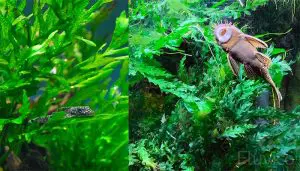

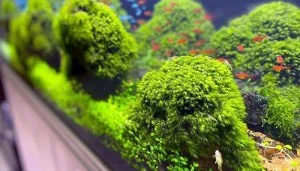
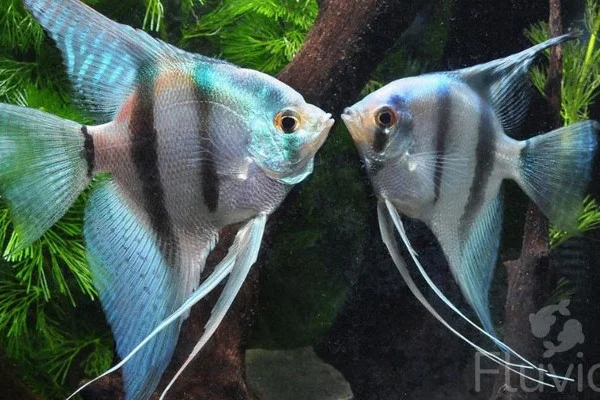


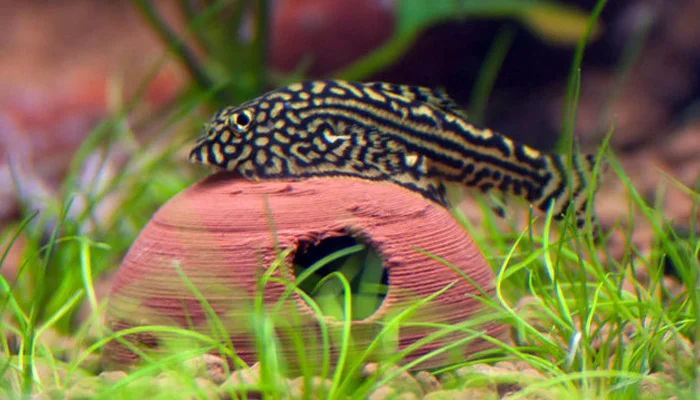
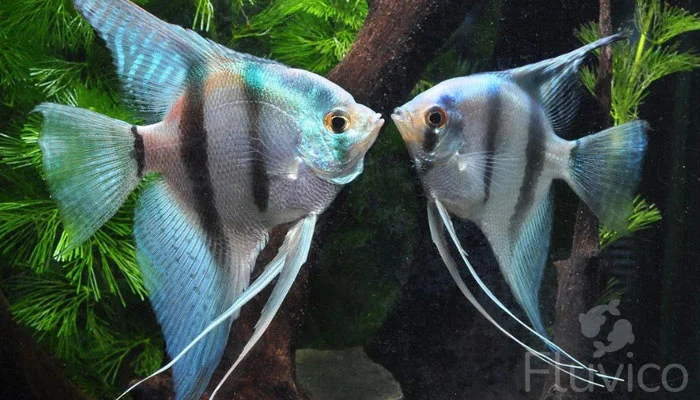
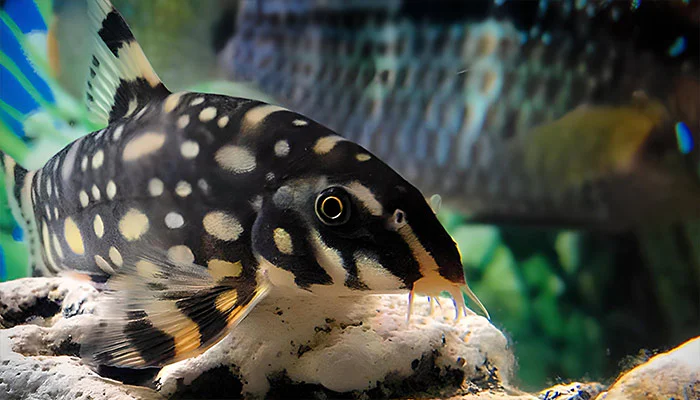
Hope you enjoyed our Kuhli Loach Care Guide!
If you have any questions? Ask away, we’re here to help!